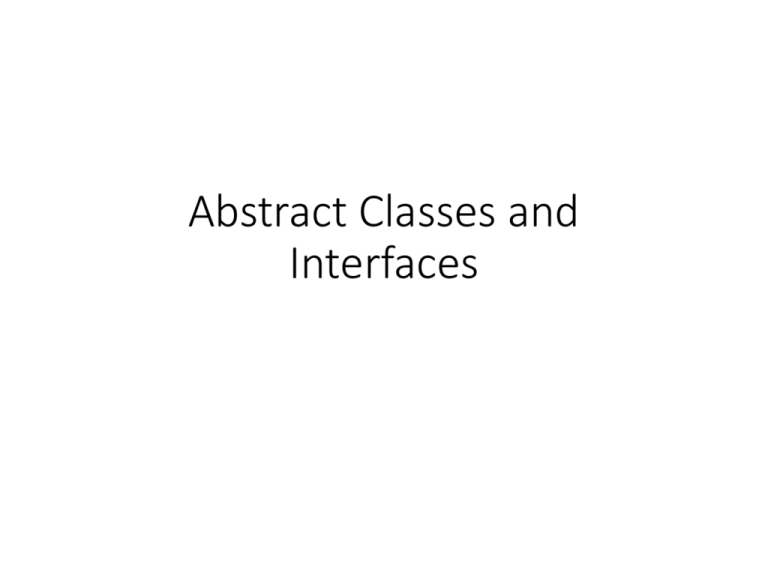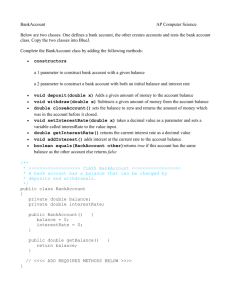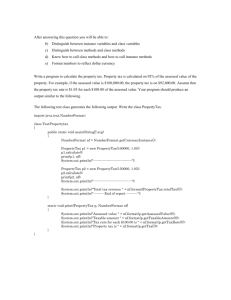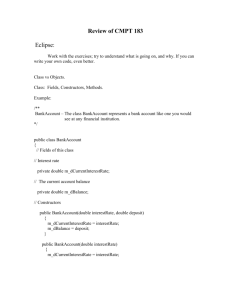
Abstract Classes and
Interfaces
Abstract Classes
• An abstract class in a class hierarchy represents a generic concept
• Common elements in a hierarchy that are too generic to instantiate
• Cannot be instantiated
• abstract on the class header:
public abstract class Product
{
// contents
}
Abstract Classes
• abstract classes typically have:
• abstract methods with no definitions (like an interface)
• probably also non-abstract methods with full definitions
• Does not have to contain abstract methods -- simply declaring it as
abstract makes it so
• The child of an abstract class must override the abstract methods of
the parent, or it too will be considered abstract
Abstract Classes
abstract class A1 {
abstract void m1();
abstract String m2();
}
class C1 extends A1 {
void m1() { System.out.println(“C1-m1”); }
String m2() { return “C1-m2”; }
}
abstract C2 extends A1 {
void m1() { System.out.println(“C2-m1”); }
}
C2 must be abstract, because it does not implement the abstract
method m2.
Abstract Classes
• Abstract methods cannot be defined as final or static
• final cannot be overridden (contradiction!)
• static could be invoked by just using the name of the class – can’t invoke it
with no implementation
Interfaces
• A Java interface is a collection of abstract methods and constants
• An abstract method is a method header without a method body
• abstract - but because all methods in an interface are abstract, usually it is
left off
• An interface establishes a set of methods that a class will implement
• Similar to abstract class but all methods are abstract (and all properties are
constant)
Interfaces
interface I1 {
int CONST1=5;
void m1();
}
Although we do not write here, it is assumed
that CONST1 is declared as a constant (with
keywords public, final and static)
Although we do not write here, it is assumed
that m1 is declared with keywords public
and abstract.
Interface methods are public by default
Interfaces
interface is a reserved word
None of the methods in
an interface are given
a definition (body)
public interface Doable
{
public void doThis();
public int doThat();
public void doThis2 (float value, char ch);
public boolean doTheOther (int num);
}
A semicolon immediately
follows each method header
Interfaces
• Defines similarities that multiple classes share
• to tie elements of several classes together - without having an inheritance
relationship, so still no multiple inheritance
• separate design from coding
• An interface cannot be instantiated
• A class implements an interface by:
• stating so in the class header
• Implementing all abstract methods in the interface, plus maybe some others
Interfaces
public class CanDo implements Doable
{
public void doThis ()
implements is a
{
reserved word
// whatever
}
public void doThat ()
{
// whatever
}
// etc.
}
Each method listed
in Doable is
given a definition
Implementing Interfaces (cont.)
• An interface can be implemented by multiple classes.
• Each implementing class can provide their own unique versions of the method
definitions.
interface I1 {
void m1() ;
}
class C1 implements I1 {
public void m1() { System.out.println(“Implementation in C1”); }
}
class C2 implements I1 {
public void m1() { System.out.println(“Implementation in C2”); }
}
Interfaces
• A class can implement multiple interfaces
• The interfaces are listed in the implements clause
• The class must implement all methods in all interfaces listed in the
header
class ManyThings implements interface1, interface2
{
// all methods of both interfaces
}
Implementing More Than One Interface
interface I1 {
void m1();
}
interface I2 {
void m2() ; C must implement all methods in I1 and I2.
void m3() ;
}
class C implements I1, I2 {
public void m1() { System.out.println(“C-m1”); }
public void m2() { System.out.println(“C-m2”); }
public void m3() { System.out.println(“C-m3”); }
}
Resolving Name Conflicts Among Interfaces
• Since a class may implement more than one interface, the names in
those interfaces may collide.
• To solve name collisions, Java use a simple mechanism.
• Two methods that have the same name will be treated as follows in
Java:
• If they are different signature, they are considered to be overloaded.
• If they have the same signature and the same return type, they are
considered to be the same method and they collapse into one.
• If they have the same signature and the different return types, a compilation
error will occur.
Resolving Name Conflicts Among Interfaces
interface I1 {
void m1();
void m2();
void m3();
}
interface I2 {
void m1(int a);
There will be a compilation error for m3.
void m2();
int m3();
}
class C implements I1, I2 {
public void m1() { … }
// implementation of m1 in I1
public void m1(int x) { … }
// implementation of m1 in I2
public void m2() { … }
// implementation of m2 in I1 and I2
}
Inheritance Relation Among Interfaces
• Same as classes, interfaces can hold inheritance relation among them
interface I2 extends I1 { … }
• Now, I2 contains all abstract methods of I1 plus its own abstract
methods.
• The classes implementing I2 must implement all methods in I1 and
I2.
Interfaces as Data Types
• Interfaces (same as classes) can be used as data types.
• Different from classes: We cannot create an instance of an interface.
interface I1 { … }
class C1 implements I1 { … }
class C2 extends C1 { … }
// a variable can be declared as type I1
I1 x;
• A variable declared as I1, can store objects of C1 and C2.
• More later…
Interfaces
• In addition to (or instead of) abstract methods, an interface can
contain constants
• When a class implements an interface, it gains access to all its
constants
• A class that implements an interface can implement other methods
as well
• See Complexity.java
• See Question.java
• See MiniQuiz.java
//********************************************************************
// Complexity.java
Author: Lewis/Loftus
//
// Represents the interface for an object that can be assigned an
// explicit complexity.
//********************************************************************
public interface Complexity
{
public void setComplexity (int complexity);
public int getComplexity();
}
//********************************************************************
// Question.java
Author: Lewis/Loftus
//
// Represents a question (and its answer).
//********************************************************************
public class Question implements Complexity
{
private String question, answer;
private int complexityLevel;
//----------------------------------------------------------------// Constructor: Sets up the question with a default complexity.
//----------------------------------------------------------------public Question (String query, String result)
{
question = query;
answer = result;
complexityLevel = 1;
}
continue
continue
//----------------------------------------------------------------// Sets the complexity level for this question.
//----------------------------------------------------------------public void setComplexity (int level)
{
complexityLevel = level;
}
//----------------------------------------------------------------// Returns the complexity level for this question.
//----------------------------------------------------------------public int getComplexity()
{
return complexityLevel;
}
//----------------------------------------------------------------// Returns the question.
//----------------------------------------------------------------public String getQuestion()
{
return question;
}
continue
continue
//----------------------------------------------------------------// Returns the answer to this question.
//----------------------------------------------------------------public String getAnswer()
{
return answer;
}
//----------------------------------------------------------------// Returns true if the candidate answer matches the answer.
//----------------------------------------------------------------public boolean answerCorrect (String candidateAnswer)
{
return answer.equals(candidateAnswer);
}
//----------------------------------------------------------------// Returns this question (and its answer) as a string.
//----------------------------------------------------------------public String toString()
{
return question + "\n" + answer;
}
}
//********************************************************************
// MiniQuiz.java
Author: Lewis/Loftus
//
// Demonstrates the use of a class that implements an interface.
//********************************************************************
import java.util.Scanner;
public class MiniQuiz
{
//----------------------------------------------------------------// Presents a short quiz.
//----------------------------------------------------------------public static void main (String[] args)
{
Question q1, q2;
String possible;
Scanner scan = new Scanner (System.in);
q1 = new Question ("What is the capital of Jamaica?",
"Kingston");
q1.setComplexity (4);
q2 = new Question ("Which is worse, ignorance or apathy?",
"I don't know and I don't care");
q2.setComplexity (10);
continue
continue
System.out.print (q1.getQuestion());
System.out.println (" (Level: " + q1.getComplexity() + ")");
possible = scan.nextLine();
if (q1.answerCorrect(possible))
System.out.println ("Correct");
else
System.out.println ("No, the answer is " + q1.getAnswer());
System.out.println();
System.out.print (q2.getQuestion());
System.out.println (" (Level: " + q2.getComplexity() + ")");
possible = scan.nextLine();
if (q2.answerCorrect(possible))
System.out.println ("Correct");
else
System.out.println ("No, the answer is " + q2.getAnswer());
}
}
continue
Sample Run
What is the capital of Jamaica? (Level: 4)
System.out.print (q1.getQuestion());
Kingston
System.out.println
(" (Level: " + q1.getComplexity() + ")");
Correct
possible = scan.nextLine();
if (q1.answerCorrect(possible))
System.out.println
("Correct");
Which
is worse, ignorance
or apathy? (Level: 10)
else
apathy
System.out.println
theknow
answer
is I" don't
+ q1.getAnswer());
No,
the answer is I("No,
don't
and
care
System.out.println();
System.out.print (q2.getQuestion());
System.out.println (" (Level: " + q2.getComplexity() + ")");
possible = scan.nextLine();
if (q2.answerCorrect(possible))
System.out.println ("Correct");
else
System.out.println ("No, the answer is " + q2.getAnswer());
}
}
Example
Example: a method to compute the average of an array of
Objects
• The algorithm for computing the average is the same in all cases
• Details of measurement differ
Goal: write one method that provides this service.
We can't call getBalance in one case and getArea in
another.
Solution: all object who want this service must agree on a
getMeasure method
• BankAccount's getMeasure will return the balance
• Country's getMeasure will return the area
Now we implement a single average method that
computes the sum:
sum = sum + obj.getMeasure();
Copyright © 2014 by John Wiley & Sons. All rights reserved.
26
Defining an Interface Type
Problem: we need to declare a type for obj
Need to invent a new type that describes any class whose
objects can be measured.
An interface type is used to specify required operations
(like getMeasure):
public interface Measurable
{
double getMeasure();
}
A Java interface type declares methods but does not
provide their implementations.
Copyright © 2014 by John Wiley & Sons. All rights reserved.
27
Syntax 8.1 Declaring an Interface
Copyright © 2014 by John Wiley & Sons. All rights reserved.
28
Defining an Interface Type
Implementing a reusable average method:
public static double average(Measurable[] objects)
{
double sum = 0;
for (Measurable obj : objects)
{
sum = sum + obj.getMeasure();
}
if (objects.length > 0) { return sum / objects.length; }
else { return 0; }
}
This method is can be used for objects of any class that
conforms to the Measurable type.
Copyright © 2014 by John Wiley & Sons. All rights reserved.
29
Implementing an Interface Type
Use implements reserved word to indicate that a class
implements an interface type:
public class BankAccount implements Measurable
{
…
public double getMeasure()
{
return balance;
}
}
BankAccount objects are instances of the Measurable
type:
Measurable obj = new BankAccount(); // OK
Copyright © 2014 by John Wiley & Sons. All rights reserved.
30
Implementing an Interface Type
A variable of type Measurable holds a reference to an
object of some class that implements the Measurable
interface.
Country class can also implement the Measurable
interface:
public class Country implements Measurable
{
public double getMeasure()
{
return area;
}
. . .
}
Use interface types to make code more reusable.
Copyright © 2014 by John Wiley & Sons. All rights reserved.
31
Implementing an Interface Type
Put the average method in a class - say Data
Figure 1 UML Diagram of the Data Class and the Classes
that Implement the Measurable Interface
Data class is decoupled from the BankAccount and
Country classes.
Copyright © 2014 by John Wiley & Sons. All rights reserved.
32
section_1/Data.java
1
2
3
4
5
6
7
8
9
10
11
12
13
14
15
16
17
18
public class Data
{
/**
Computes the average of the measures of the given objects.
@param objects an array of Measurable objects
@return the average of the measures
*/
public static double average(Measurable[] objects)
{
double sum = 0;
for (Measurable obj : objects)
{
sum = sum + obj.getMeasure();
}
if (objects.length > 0) { return sum / objects.length; }
else { return 0; }
}
}
Copyright © 2014 by John Wiley & Sons. All rights reserved.
33
section_1/MeasurableTester.java
1
2
3
4
5
6
7
8
9
10
11
12
13
14
15
16
17
18
19
20
21
22
23
24
25
26
/**
This program demonstrates the measurable BankAccount and Country classes.
*/
public class MeasurableTester
{
public static void main(String[] args)
{
Measurable[] accounts = new Measurable[3];
accounts[0] = new BankAccount(0);
accounts[1] = new BankAccount(10000);
accounts[2] = new BankAccount(2000);
double averageBalance = Data.average(accounts);
System.out.println("Average balance: " + averageBalance);
System.out.println("Expected: 4000");
Measurable[]
countries[0]
countries[1]
countries[2]
countries = new Measurable[3];
= new Country("Uruguay", 176220);
= new Country("Thailand", 513120);
= new Country("Belgium", 30510);
double averageArea = Data.average(countries);
System.out.println("Average area: " + averageArea);
System.out.println("Expected: 239950");
}
Continued
}
Copyright © 2014 by John Wiley & Sons. All rights reserved.
34
section_1/MeasurableTester.java
Program Run:
Average balance: 4000
Expected: 4000
Average area: 239950
Expected: 239950
Copyright © 2014 by John Wiley & Sons. All rights reserved.
35
Self Check 8.1
Suppose you want to use the average method to find the
average salary of an array of Employee objects. What
condition must the Employee class fulfill?
Answer: It must implement the Measurable interface,
and its getMeasure method must return the salary.
Copyright © 2014 by John Wiley & Sons. All rights reserved.
36
Self Check 8.4
What is wrong with this code?
Measurable meas = new Measurable();
System.out.println(meas.getMeasure());
Answer: Measurable is not a class. You cannot
construct objects of type Measurable.
Copyright © 2014 by John Wiley & Sons. All rights reserved.
37
Self Check 8.5
What is wrong with this code?
Measurable meas = new Country("Uruguay", 176220);
System.out.println(meas.getName());
Answer: The variable meas is of type Measurable, and
that type has no getName method.
Copyright © 2014 by John Wiley & Sons. All rights reserved.
38
Interfaces
• The Java standard class library contains many helpful interfaces
• The Comparable interface contains one abstract method called
compareTo, which is used to compare two objects
• We discussed the compareTo method of the String class before
• The String class implements Comparable, giving us the ability to put
strings in lexicographic order
The Comparable Interface
• Any class can implement Comparable to provide a mechanism for
comparing objects of that type
if (obj1.compareTo(obj2) < 0)
System.out.println ("obj1 is less than obj2");
• The value returned from compareTo should be negative if
obj1 is less that obj2, 0 if they are equal, and positive if
obj1 is greater than obj2
• When a programmer designs a class that implements the
Comparable interface, it should follow this intent
The Comparable Interface
• It's up to the programmer to determine what makes one object less
than another
• For example, you may define the compareTo method of an Employee
class to order employees by name (alphabetically) or by employee
number
• The implementation of the method can be as straightforward or as
complex as needed for the situation
The Comparable Interface
BankAccount class' implementation of Comparable:
public class BankAccount implements Comparable
{
. . .
public int compareTo(Object otherObject)
{
BankAccount other = (BankAccount) otherObject;
if (balance < other.balance) { return -1; }
if (balance > other.balance) { return 1; }
return 0;
}
. . .
}
compareTo method has a parameter of reference type
Object
To get a BankAccount reference:
BankAccount other = (BankAccount) otherObject;
Copyright © 2014 by John Wiley & Sons. All rights reserved.
42
The Comparable Interface
Because the BankAccount class implements the
Comparable interface, you can sort an array of bank
accounts with the Arrays.sort method:
BankAccount[] accounts = new BankAccount[3];
accounts[0] = new BankAccount(10000);
accounts[1] = new BankAccount(0);
accounts[2] = new BankAccount(2000);
Arrays.sort(accounts);
Now the accounts array is sorted by increasing balance.
The compareTo method checks whether another object is
larger or smaller.
Copyright © 2014 by John Wiley & Sons. All rights reserved.
43
Self Check 8.14
Write a method max that finds the larger of any two
Comparable objects.
Answer:
public static Comparable max(Comparable a,
Comparable b)
{
if (a.compareTo(b) > 0) { return a; }
else { return b; }
}
Copyright © 2014 by John Wiley & Sons. All rights reserved.
44
Self Check 8.15
Write a call to the method of Self Check 14 that computes
the larger of two bank accounts, then prints its balance.
Answer:
BankAccount larger =
(BankAccount) max(first, second);
System.out.println(larger.getBalance());
Note that the result must be cast from Comparable to
BankAccount so that you can invoke the getBalance
method.
Copyright © 2014 by John Wiley & Sons. All rights reserved.
45
The Iterator Interface
• As we discussed, an iterator is an object that provides a means of
processing a collection of objects one at a time
• An iterator is created formally by implementing the Iterator
interface, which contains three methods
• The hasNext method returns a boolean result – true if there are
items left to process
• The next method returns the next object in the iteration
• The remove method removes the object most recently returned by
the next method
The Iterator Interface
• By implementing the Iterator interface, a class formally establishes
that objects of that type are iterators
• The programmer must decide how best to implement the iterator
functions
• Once established, the for-each version of the for loop can be used to
process the items in the iterator
When to use Abstract Methods &
Abstract Class?
• Abstract methods are usually declared where two or more subclasses
are expected to fulfill a similar role in different ways through
different implementations
• These subclasses extend the same Abstract class and provide different
implementations for the abstract methods
• Use abstract classes to define broad types of behaviors at the top of
an object-oriented programming class hierarchy, and use its
subclasses to provide implementation details of the abstract class.
Why do we use Interfaces?
Reason #1
• To reveal an object's programming interface (functionality of the
object) without revealing its implementation
• This is the concept of encapsulation
• The implementation can change without affecting the caller of the interface
• The caller does not need the implementation at the compile time
• It needs only the interface at the compile time
• During runtime, actual object instance is associated with the interface type
Why do we use Interfaces?
Reason #2
• To have unrelated classes implement similar methods (behaviors)
• One class is not a sub-class of another
• Example:
• Class Line and class MyInteger
• They are not related through inheritance
• You want both to implement comparison methods
• checkIsGreater(Object x, Object y)
• checkIsLess(Object x, Object y)
• checkIsEqual(Object x, Object y)
• Define Comparison interface which has the three abstract methods above
Why do we use Interfaces?
Reason #3
• To model multiple inheritance
• A class can implement multiple interfaces while it can extend only one class
Interface vs. Abstract Class
• All methods of an Interface are abstract methods while some
methods of an Abstract class are abstract methods
• Abstract methods of abstract class have abstract modifier
• An interface can only define constants while abstract class can have
fields
• Interfaces have no direct inherited relationship with any particular
class, they are defined independently
• Interfaces themselves have inheritance relationship among themselves
Problem of Rewriting an Existing
Interface
• Consider an interface that you have developed called DoIt:
public interface DoIt {
void doSomething(int i, double x);
int doSomethingElse(String s);
}
• Suppose that, at a later time, you want to add a third method to DoIt,
so that the interface now becomes:
public interface DoIt {
void doSomething(int i, double x);
int doSomethingElse(String s);
boolean didItWork(int i, double x, String s);
}
If you make this change, all classes that
implement the old DoIt interface will break
because they don't implement all methods of
the interface anymore
Solution of Rewriting an Existing
Interface
• Create more interfaces later
• For example, you could create a DoItPlus interface that extends DoIt:
public interface DoItPlus extends DoIt {
boolean didItWork(int i, double x, String s);
}
• Now users of your code can choose to continue to use the old
interface or to upgrade to the new interface
When to use an Abstract Class
over Interface?
• For non-abstract methods, you want to use them when you want to
provide common implementation code for all sub-classes
• Reducing the duplication
• For abstract methods, the motivation is the same with the ones in
the interface – to impose a common behavior for all sub-classes
without dictating how to implement it
• Remember a concrete can extend only one super class whether that
super class is in the form of concrete class or abstract class






